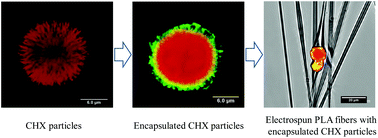Electrospun poly(lactic acid) fibers containing novel chlorhexidine particles with sustained antibacterial activity†
Abstract
The treatment of persistent infections often requires a high local drug concentration and sustained release of antimicrobial agents. This paper proposes the use of novel electrospinning of poly(lactic acid) (PLA) fibers containing uncoated and encapsulated chlorhexidine particles. Chlorhexidine particles with a mean (SD) diameter of 17.15 ± 1.99 μm were fabricated by the precipitation of chlorhexidine diacetate with calcium chloride. Layer-by-layer (LbL) encapsulation of the chlorhexidine particles was carried out to produce encapsulated particles. The chlorhexidine particles had a high chlorhexidine content (90%), and when they were electrospun into PLA fibers a bead-in-string structure was obtained. The chlorhexidine content in the fibers could be tuned and a sustained release over 650 h was produced, via chlorhexidine particle encapsulation. Chlorhexidine release was governed by the polyelectrolyte multilayer encapsulation as demonstrated by SEM and confocal imaging. The incorporation of uncoated and encapsulated chlorhexidine particles (0.5% and 1% wt/wt chlorhexidine) into the fibers did not cause toxicity to healthy fibroblasts or affect cell adhesion to the fibers over a period of 5 days. The chlorhexidine-containing fibers also demonstrated sustained antibacterial activity against E. coli via an agar diffusion assay and broth transfer assay. Therefore, the chlorhexidine-containing PLA fibers may be useful in the treatment of persistent infections in medicine and dentistry.


 Please wait while we load your content...
Please wait while we load your content...